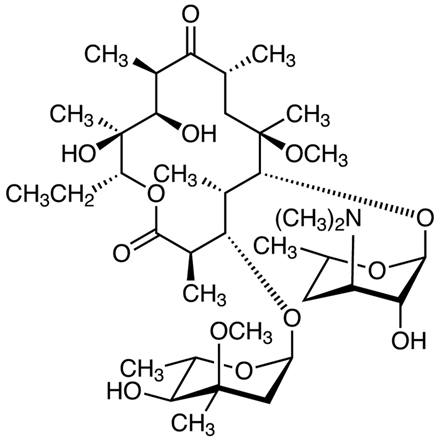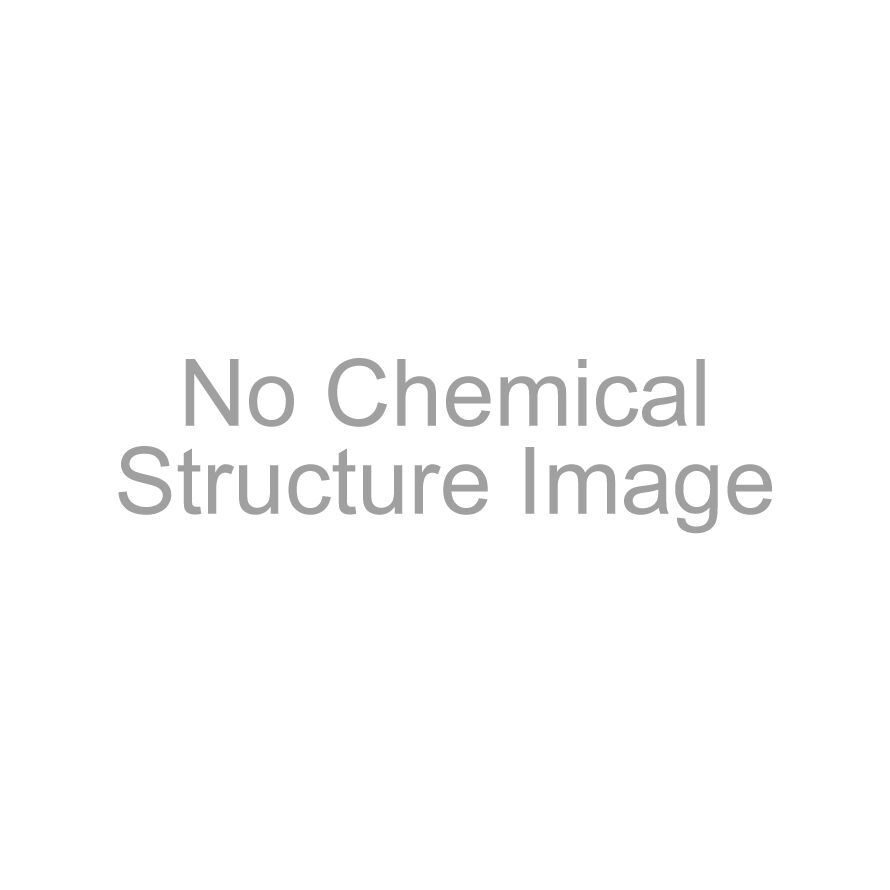Published TCIMAIL newest issue No.199
Maximum quantity allowed is 999
Bitte wählen Sie die Menge aus.
CAS RN: 81103-11-9 | Produkte #: C2220
Clarithromycin

Reinheit: >98.0%(T)
Synonyme
Produktdokumente:
| Einheit | Stückpreis | Belgien | Japan* | Menge |
|---|---|---|---|---|
| 1G |
€42.00
|
9 | ≥40 |
|
| 5G |
€135.00
|
7 | ≥40 |
|
| 25G |
€465.00
|
1 | ≥60 |
|
*In Belgien verfügbare Lagerbestände werden in 1 bis 3 Tagen geliefert.
*In Japan verfügbare Lagerbestände werden in 1 bis 2 Wochen geliefert. (unter Ausschluss von regulierten Artikeln und Trockeneislieferungen).
| Artikel # | C2220 |
Reinheit / Analysenmethode 
|
>98.0%(T) |
| Summenformel / Molekülmasse | C__3__8H__6__9NO__1__3 = 747.96 |
| Physikalischer Zustand (20 °C) | Solid |
Lagerungstemperatur 
|
Room Temperature (Recommended in a cool and dark place, <15°C) |
Verpackung und Behälter 
|
1G-Glass Bottle with Plastic Insert (Bild ansehen) |
| CAS RN | 81103-11-9 |
| Reaxys Registrierungsnummer | 3581974 |
| PubChem-Stoff-ID | 87560041 |
| Spektrale Daten (AIST) Link | 52165 |
| Merck-Index (14) | 2339 |
| MDL-Nummer | MFCD00865140 |
Spezifikation
| Appearance | White powder to crystal |
| Purity(Nonaqueous Titration) | min. 98.0 % |
| Melting point | 222.0 to 227.0 °C |
| Specific rotation [a]20/D | -87.0 to -97.0 deg(C=1, CHCl3) |
Eigenschaften
| Schmelzpunkt | 225 °C |
| Optische Aktivität | -92° (C=1,CHCl3) |
| Löslichkeit (löslich in) | Ether, Ethanol, Methanol |
GHS
| Piktogramm |

|
| Signalwort | Achtung |
| Gefahrenhinweise | H302 : Gesundheitsschädlich bei Verschlucken. |
| Sicherheitshinweise | P501 : Inhalt/ Behälter einer anerkannten Abfallentsorgungsanlage zuführen. P270 : Bei Gebrauch nicht essen, trinken oder rauchen. P264 : Nach Gebrauch Haut gründlich waschen. P301 + P312 + P330 : BEI VERSCHLUCKEN: Bei Unwohlsein GIFTINFORMATIONSZENTRUM/Arzt anrufen. Mund ausspülen. |
Verwandte Gesetze:
| RTECS # | KF4997000 |
Transportinformationen:
| HS-Nr. (Import / Export) (TCI-E) | 2941900000 |
Anwendung
Clarithromycin: A More Acid-Stable Semi-Synthetic Macrolide Antibiotic
Macrolide antibiotics are classified by the size of the macrocyclic lactone ring of aglycone as 14-, 15- or 16-membered ring macrolides. Macrolides are characterized by similar chemical structures, mechanisms of action and resistance, but vary in the different pharmacokinetic parameters, and spectrum of activity. Clarithromycin (abbrev: CAM) is chemically synthesized by substituting a methyl group for the C-6 hydroxyl group of erythromycin [E0751]. This substitution creates a more acid-stable antimicrobial and prevents the degradation of the erythromycin base to the hemiketal intermediate. CAM is primarily metabolized by cytochrome P450 (CYP) 3A isoenzymes to an active metabolite, 14-hydroxyclarithromycin. CAM has activity against a wide range of Gram-positive bacteria including Streptococcus and Staphylococcus, and limited activity against Gram-negative bacteria, similar to that of erythromycin. CAM demonstrates greater in vitro activity than erythromycin against certain pathogens including Hemophilus influenza and Helicobacter pylori. However, bacterial strains resistant to erythromycin are also generally resistant to clarithromycin. CAM inhibits protein synthesis in susceptible organisms by binding to specific nucleotides in 23S rRNA within the 50S subunit of the bacterial ribosome. CAM and macrolides also shows gastrointestinal motor stimulating activity as a motilin-agonist, and anti-inflammatory or immunomodulatory activity.
References
- Clarithromycin: a review of its antimicrobial activity, pharmacokinetic properties and therapeutic potential
- The macrolides: erythromycin, clarithromycin, and azithromycin (a review)
- Mutations in 23S rRNA are associated with clarithromycin resistance in Helicobacter pylori
- Erythromycin and other macrolides as prokinetic agents (a review)
- Macrolides: from in vitro anti-inflammatory and immunomodulatory properties to clinical practice in respiratory diseases (a review)
PubMed Literatur
Dokumente
Produktartikel
Produktdokumente (Hinweis: Für einige Produkte sind keine Analysediagramme verfügbar.)
Sicherheitsdatenblatt (SDB)
Bitte wählen Sie Sprache.
Das angeforderte SDB ist nicht verfügbar.
Bitte Kontaktieren Sie uns für mehr Informationen.
Spezifikationsdokumenten
AZ & andere Zertifikate
Bitte geben Sie die Lotnummer ein
Falsche Chargennummer wurde eingegeben. Bitte geben Sie nur 4-5 alphanumerische Zeichen vor dem Bindestrich ein.
Muster-AZ
Dies ist ein Muster-AZ und repräsentiert möglicherweise nicht eine kürzlich hergestellte Charge des Produkts.
Ein Muster-AZ für dieses Produkt ist zur Zeit nicht verfügbar.
Analytische Diagramme

Bitte geben Sie die Lotnummer ein
Falsche Chargennummer wurde eingegeben. Bitte geben Sie nur 4-5 alphanumerische Zeichen vor dem Bindestrich ein.
Das angeforderte Analysediagramm ist nicht verfügbar. Wir entschuldigen uns für die Unannehmlichkeiten.





